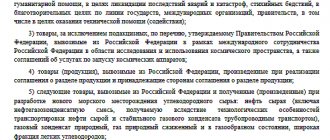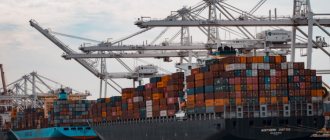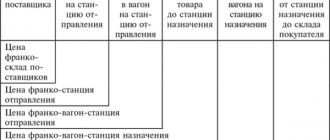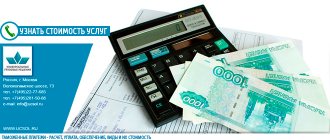Excise taxation is an important means of replenishing the state budget and taking into account its interests. The main problems of such taxation are the complexity of the mechanisms for calculating excise taxes and their payment, as well as the constant change in regulations and various innovations.
The use of different types of rates for different categories of excisable products serves to facilitate the determination of the tax base, calculation of tax amounts and optimization of calculation methods.
What is excise tax
Excise tax is a special tax, also indirect, like VAT. We can say that this is a premium that is “hidden” in the selling price of a product, and its purpose is to regulate demand. As in the case of VAT, the payment of excise tax falls on the shoulders of the end consumer, and the entrepreneur or company only transfers this tax to the state.
Excise tax is a federal tax, so the rules for its calculation and payment are the same in all regions of the country and there are no regions that are exempt from paying excise taxes. The tax office vigilantly monitors the payment of this duty, because they bring 5-8% of funds to the state budget.
Application procedure
The application of rates depends on what goals the state pursues by imposing an excise tax on a particular product.
- When inflation is high, the ad valorem rate is most beneficial, since as the cost of the product increases, the tax amount also increases.
- With a decrease in inflation rates, a specific rate with annual indexation becomes more profitable. When applying this rate, control over the payment of taxes is facilitated, since it is necessary to determine the quantity of products sold or produced, as opposed to control over price dynamics. In addition, this type of rate is used to reduce the consumption of a particular product.
By the way, the fact that the specific rate does not depend on the price of this product is a disadvantage of this type of rate. This leads to regressiveness of indirect taxation.
- To increase progressiveness, the Russian Federation has adopted the use of multi-level specific (fixed) rates or their differentiation depending on certain parameters.
The impact of different types of rates on profit, price, quality and range of goods, profit distribution and administration is different. The merit of a particular bet varies depending on how you evaluate their effectiveness. The state is interested in increasing the amount of taxes withdrawn, tax efficiency, ease of administration, and increasing consumer welfare. The consumer cares about prices, variety and quality of an individual product.
The marginal and average tax rates are described in the video below:
What goods are excisable?
There is a list of goods that are “designated” as excisable, that is, when trading these goods you have to pay excise tax, and it does not matter whether they were produced in Russia or abroad. Usually these are popular high-margin products, their list is constantly changing, it is given in paragraph 1 of Art. 181 Tax Code of the Russian Federation. For example, the list contains:
- products containing alcohol up to 9%;
- alcoholic drinks - wines, ciders, beer with an alcohol content of more than 0.5%;
- tobacco and all types of tobacco products;
- electronic cigarettes with nicotine and refills for them;
- fuel: stove, diesel
- motor oils;
- petrol;
- Cars;
- motorcycles with an engine power of more than 150 hp.
Some excisable goods need to be marked (tobacco, alcohol), others do not (motorcycles, cars).
Each group of excisable goods has exceptions, for example:
- medical and veterinary products containing alcohol (must be included in the list of drugs or veterinary products);
- perfumes containing alcohol (there are requirements for the percentage of alcohol and the volume of the bottle);
- wine-containing materials - musts from grapes, apples, wheat, etc.
Excise taxes on alcohol and tobacco are believed to help curb the consumption of these harmful substances. Excise taxes on automobile fuel and oils become a kind of payment for road use and environmental pollution. And excise taxes on luxury goods (caviar, sturgeon, etc.) help redistribute funds.
Keep records of exports and imports in the Kontur.Accounting web service. Simple accounting, payroll and reporting in one service
Ethanol
Now, in a nutshell, we will tell you why the following goods are excisable if they contain ethanol.
Concept
The definition of the term is given in Federal Law No. 171. This is a substance with the formula C2H5OH, made from natural or synthetic raw materials, including raw alcohol and denatured alcohol. When assigning a liquid to this category, the criteria listed in the relevant regulatory documents - GOST, OST, TU - are taken into account.
Kinds
The classification of dozens of varieties is based on:
- raw material;
- forcing method;
- cleaning depth;
- the presence of harmful impurities or additives, their concentration.
Which of the following is subject to excise tax?
All presented varieties, excluding cognac spirit, are subject to excise taxation. This was enshrined in a 2007 decree. At the same time, a single rate was fixed - 23.5 rubles per 1 liter.
Who pays excise tax
Excise tax payers (Article 179 of the Tax Code of the Russian Federation) are Russian and foreign:
- individual entrepreneurs;
- organizations;
- individuals who transport goods across the border of the Customs Union.
In most cases, excise tax is paid for the following actions with goods:
- sale;
- Border crossing;
- production;
- transfer for further production;
- transfer to the person who provided the raw materials for the production of the goods;
- transfer for processing;
- transfer to an employee who leaves the company.
The obligation to pay excise tax does not always arise. Some groups of goods require payment of tax only for specific transactions: for example, producers of straight-run gasoline pay excise tax, but sellers do not.
Manufacturers are exempt from excise taxes (Article 183 of the Tax Code of the Russian Federation) if they transfer goods within the company's divisions for further production (except in some cases), if they export goods abroad, during the first sale of confiscated goods. For exemption, special conditions must be met: separate accounting of excisable and non-excise goods, bank guarantees (Articles 184, 195, 204 of the Tax Code of the Russian Federation).
Who transfers funds to the budget
In general, the payer of this type of tax is the manufacturer of excisable goods. But special cases are possible when funds are transferred to the budget by other persons, for example, recipients of goods. Let's consider each of these situations in detail.
Payment of excise duty by the manufacturer
The most common situation in practice is that the excise tax is paid directly by the manufacturer of the product. If you produce excisable goods, then you are required to charge the amount of tax:
- at the time of sale of the goods. This fact is confirmed by the transfer of ownership from your company to the purchasing company;
- in barter transactions and payment in kind. If you transfer goods as payment for labor (except for alcoholic beverages), then you are required to charge excise duty at the time of transfer of goods to employees;
- when transferring goods under a pledge agreement. It should be noted that you are not charged excise tax at the time of transfer of collateral, but only when you lose ownership of the goods;
- in the event that a shortage of goods is detected in excess of the established norm of natural loss;
- when transferring goods without payment (for example, you transferred product samples or carried out an advertising campaign);
- in the event that the products are transferred from you to another person for subsequent processing. For example, an alcohol distillate is transferred to a winery for the production of sparkling wine. In this situation, the excise tax is paid upon transfer of the distillate to the winery;
- when moving goods within the company. You are required to charge excise tax if you transfer the goods to another structural unit for its own use of the products. Tax is also charged when the representative office receives products for the subsequent manufacture of non-excisable goods No.
- at the time of departure of goods from the organization. For example, you transfer goods to receivers or heirs according to a will;
- when contributing goods as a contribution to the authorized capital.
Excise tax is paid by other persons
In certain cases, the amount of the tax payment is transferred to the budget not by the direct manufacturer of the product, but by other persons.
You are required to pay excise tax if your organization has a certificate for the production of non-alcohol-containing products. You must charge the excise tax at the time denatured ethyl alcohol is entered into the balance sheet.
If you purchase alcohol (ethyl or cognac) for the purpose of further production of alcoholic products, then in addition to calculating the tax at the time the alcohol is registered, you are also required to make an advance payment for the tax.
For oil refineries, tax obligations may arise upon receipt of straight-run gasoline. In this case, the company must have a certificate for processing this petroleum product.
If you import excisable goods, then you will have to pay the tax upon import of the goods into the territory of the Russian Federation. Further, when selling products, you do not need to pay tax.
What are the excise tax rates?
There are three types of excise rates:
- solid - a certain amount per unit of measurement (for example, per liter), this rate works for all excisable goods, except for cigarettes and cigarettes;
- ad valorem - a percentage of the cost of the goods (mentioned in the Tax Code of the Russian Federation, but not used in practice);
- combined - consist of the amount per unit of measurement and a percentage of the maximum cost, this rate works for cigarettes and cigarettes.
Each type of product in a category has its own rate: for example, each class of gasoline has its own rate.
Keep records of exports and imports in the Kontur.Accounting web service. Simple accounting, payroll and reporting in one service
Minimum and maximum retail price
The organization does not have the right to sell tobacco products at a price below the minimum retail price and above the maximum (Clause 5, Article 13 of Law No. 15-FZ of February 23, 2013).
The maximum retail price is the price above which a pack of cigarettes or cigarettes cannot be sold to end consumers. This price must be indicated on the package. This is stated in paragraph 2 of Article 187.1 of the Tax Code of the Russian Federation.
The maximum retail price is set independently by the manufacturer for each brand (name) of cigarettes and cigarettes. Therefore, using the above formula, you need to determine the estimated cost for each brand (each name) of sold cigarettes or cigarettes. And then, if the excise tax rate on them is the same, add the resulting values to determine the final estimated cost. This follows from the provisions of Article 187 of the Tax Code of the Russian Federation.
Information from manufacturers on maximum retail prices for tobacco products is published on the official website of the Federal Tax Service of Russia.
The minimum retail price is 75 percent of the maximum retail price established by the manufacturer (clause 3 of article 13 of the Law of February 23, 2013 No. 15-FZ).
Situation: can an organization set different maximum retail prices for cigarettes of the same name? Cigarettes are sold in different regions, and the costs of their sale differ.
Yes, it can, if cigarettes of the same name, which are sold in different regions of Russia, are classified as different brands.
The maximum retail price, which must be indicated on a pack of cigarettes or cigarettes, is set by tobacco product manufacturers separately for each brand (clause 2 of Article 187.1 of the Tax Code of the Russian Federation). In this case, a brand is understood as an assortment position of tobacco products that differs from other brands in at least one of the following characteristics:
- Name;
- recipe;
- dimensions;
- presence or absence of a filter;
- package.
For example, cigarettes intended for sale in the Far North may differ from cigarettes of the same name sold in other regions in the color of the packaging. Changing packaging gives manufacturers the right to classify cigarettes of the same name as different brands. As a result, set different maximum retail prices for them.
Similar explanations are contained in the letter of the Ministry of Finance of Russia dated January 20, 2009 No. 03-07-06/4.
Attention: for the sale of cigarettes and cigarettes at a price exceeding the maximum retail price indicated on each package (pack), administrative liability is provided:
- for officials – a fine of 50,000 rubles. or disqualification for up to three years;
- for legal entities - a fine of two times the amount of excess revenue received as a result of the sale of cigarettes or cigarettes at a price higher than that indicated on the pack. Excess revenue received is determined for the entire period of sale of such goods, but not more than for 1 year (Part 1 of Article 14.6 of the Code of Administrative Offenses of the Russian Federation).
How to calculate the excise tax amount
To calculate, you need to know the rate and tax base. For each type of excisable goods, the tax base (NB) is determined in its own way (Article 187 of the Tax Code of the Russian Federation).
- For goods with specific rates, NB is the volume/quantity of goods sold or transferred.
- For goods with a combined rate (cigarettes and cigarettes), the NB consists of two parts. The first part is the volume/quantity of goods sold or transferred, the second part is the estimated cost of these goods, that is, the product of the maximum cost of a unit of goods (pack) by the quantity of goods. Manufacturers have put a maximum price on each pack of cigarettes since 2007; the product cannot be sold above this price, and there are fines for inflating the price.
For the first group of goods with a fixed rate, the amount of excise duty is calculated using the formula:
Tax base * Excise tax rate
For the second group of goods with a combined rate, the amount of excise duty is calculated using the formula:
Tax base by quantity of goods * Rate per piece of goods + Assigned percentage * Maximum price of goods
Who installs them
Rates are set by the Russian Government.
- Excise tax rates and the procedure for their application for certain types of mineral raw materials, with the exception of oil, are determined by the Government separately for each deposit. This depends on the mining, geological, geographical, and economic conditions during their extraction.
- For oil, rates are also approved differentially depending on conditions in accordance with the weighted average excise tax rate.
Excise tax rates are revised annually upward, because excisable goods are a significant source of income for the state treasury. The establishment of the rate depends on the types or subtypes of products in relation to which the rate is applied.
For example, starting from 2011, excise rates on motor gasoline and diesel fuel depend on the quality of these products. The higher the quality of the fuel, the lower the rate.
Indexation of fixed rates is carried out depending on the expected price indices for consumer goods.
When are excise taxes paid?
The tax period for excise taxes is one calendar month. For all excisable goods except alcohol, excise duty is paid twice in equal shares for one period:
- The first payment is made before the 25th of the month after the month in which the excisable goods were sold/transferred.
- The second payment is made before the 15th month after the sale/transfer of the goods.
Other rules for alcohol and alcohol-containing products:
- for alcohol sold from the 1st to the 15th of the month, excise duty is paid until the 25th of the same month;
- For alcohol sold from the 15th to the end of the month, excise duty is paid until the 15th of the next month.
For excise taxes, deductions can be applied, similar to VAT; the conditions for deductions are specified in Art. 200 and Art. 201 Tax Code of the Russian Federation. For example, a deduction can be made if you use an excisable product as a raw material in the production of other excisable goods, and you paid excise tax to the seller or to the budget when importing the goods, and the excise tax rates are set per NB unit of measurement.
Keep records, pay salaries and report in the cloud service Kontur.Accounting. The service automatically makes most calculations, reminds you of payment and reporting dates, and has tools for financial control and tax optimization. The first two weeks of work are free for all newbies.
Registration of minimum and maximum prices
To establish the minimum and maximum retail prices, the manufacturer must submit to the tax office at the place of registration (customs authority at the place of declaration) a notification of the minimum and maximum retail prices for tobacco products.
The notification form for tax inspectorates (in relation to tobacco products produced in Russia), as well as the electronic format and procedure for filling out the form, were approved by Order of the Federal Tax Service of Russia dated March 28, 2014 No. ММВ-7-3/120.
The notification form for customs (for imported tobacco products) is not currently approved.
The notification must be submitted no later than 10 calendar days before the start of the tax period, starting from which the maximum retail prices indicated in the notification will be applied to the packaging.
The organization has the right to change the maximum retail price of cigarettes or cigarettes. To do this, you need to submit a new notification. The maximum retail prices indicated therein must be indicated on packs from the first day of the month following the date of submission of the notification, but not earlier than the expiration of the minimum validity period of the previous notification.
If an organization, by the beginning of the month from which new maximum retail prices are applied to packs, has unsold balances of cigarettes, then a situation may arise when tobacco products of the same name with different maximum retail prices are sold during the tax period. In such a case, the estimated value is determined in relation to each maximum retail price. Then the total estimated cost of sold cigarettes or cigarettes of this brand is determined.
This procedure follows from the provisions of Article 187.1 of the Tax Code of the Russian Federation.










